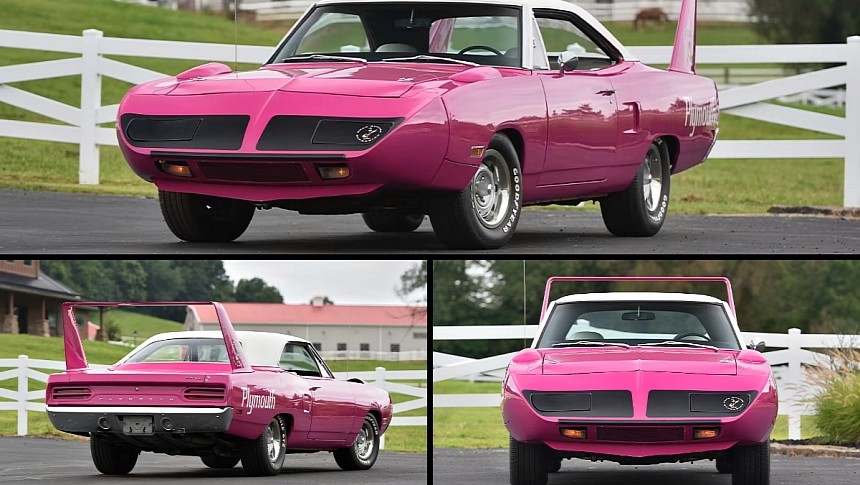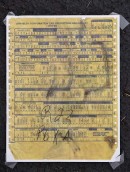Introduced in 1970, the Superbird was Plymouth's take on the Dodge Charger Daytona, a homologation muscle car developed with NASCAR racing in mind. The Superbird looked almost identical to the Daytona and arrived in showrooms with a selection of Mopar's most potent big-block V8 engines.
But unlike the Daytona, which saw daylight in just 503 examples, the Superbird spawned almost 2,000 units. This makes it more common than its Dodge sibling, but the Superbird is still among the rarest and most desirable muscle cars. To the point where HEMI-powered examples can change hands for more than $1 million.
Specific production numbers remain a mystery, with estimates ranging from 1,920 to as many as 2,783 examples built. However, most Superbird experts agree that Plymouth made 1,935 for the US market, with an additional 34 to 47 units shipped to Canada. That's a lot when compared to the Daytona but still exclusive by early 1970s muscle car standards.
Like most high-profile US performance cars from the era, the Superbird was restricted to Chrysler's top-of-the-line V8 engines. The base Superbird came with the 440-cubic-inch "Commando" RB rated 375 horsepower. Next was the six-barrel "Super Commando" version of the same mill, which generated 390 horses. Finally, the HEMI version rocked the almighty 426-cubic-inch V8, good for 425 horsepower.
The Superbird was also a bit more exclusive than the Road Runner regarding colors. That's because Plymouth offered it in just seven hues. The palette included Alpine White, Limelight, Lemon Twist, Tor-Red, Vitamin C, B5 Blue, and Corporate Blue (also known as Petty Blue). Lemon Twist is the most common color applied on more than 400 cars. Which one is the rarest, then? Well, most statistics say Petty Blue found its way on only around 50 examples.
However, it turns out Plymouth accidentally painted a few cars in Burnt Orange, a color that wasn't officially part of the color palette. While some sources indicate a handful of units finished in this color, others quote only a couple of examples. Either way, Burnt Orange cars are arguably the rarest Superbirds out there. But some customers also opted to repaint their Superbirds, thus creating one-of-none vehicles. Like the Moulin Rouge example you see here.
A base four-barrel 440 car scheduled to go under the hammer at the Kissimmee auction in January 2024, this Superbird wasn't born like this. A quick look at the fender tag and broadcast sheet reveals it was finished in FJ5, the code for Limelight Poly, a lively shade of green. But at some point, someone decided to give it a pink coating. This color was indeed available on some Plymouths in 1970 as Moulin Rouge (Dodge called it Panther Pink). It was a spring color only in 1970 and a special-order paint in 1971.
It's a rather controversial hue to have on a muscle car, but I think this Superbird looks the part since the Moulin Rouge is combined with a white vinyl top and white seats. But I'm a big fan of pink Mopars, so I'm very biased here. And I would pick it over any other factory-correct Superbird, to be honest. Okay, maybe it needs a 426 HEMI to be perfect, but it's the next best thing.
Flashy color aside, this Superbird looks perfect inside and out, thanks to a professional restoration. The engine bay is also amazingly clean. It comes with a floor shift automatic, power steering, power brakes, a full console, and bucket seats. The odometer reads 44,797 miles (72,094 km), but it's unclear whether it's the actual mileage.
If you're in the market for an unusual and delicious Superbird, this Mopar is going under the hammer at the Kissimmee auction in January 2024. It's part of the Kevin Sergent Mopar & Wing Car Collection, including nine more Superbirds and a 1969 Dodge Daytona. How much do you think it will go for?
Specific production numbers remain a mystery, with estimates ranging from 1,920 to as many as 2,783 examples built. However, most Superbird experts agree that Plymouth made 1,935 for the US market, with an additional 34 to 47 units shipped to Canada. That's a lot when compared to the Daytona but still exclusive by early 1970s muscle car standards.
Like most high-profile US performance cars from the era, the Superbird was restricted to Chrysler's top-of-the-line V8 engines. The base Superbird came with the 440-cubic-inch "Commando" RB rated 375 horsepower. Next was the six-barrel "Super Commando" version of the same mill, which generated 390 horses. Finally, the HEMI version rocked the almighty 426-cubic-inch V8, good for 425 horsepower.
The Superbird was also a bit more exclusive than the Road Runner regarding colors. That's because Plymouth offered it in just seven hues. The palette included Alpine White, Limelight, Lemon Twist, Tor-Red, Vitamin C, B5 Blue, and Corporate Blue (also known as Petty Blue). Lemon Twist is the most common color applied on more than 400 cars. Which one is the rarest, then? Well, most statistics say Petty Blue found its way on only around 50 examples.
However, it turns out Plymouth accidentally painted a few cars in Burnt Orange, a color that wasn't officially part of the color palette. While some sources indicate a handful of units finished in this color, others quote only a couple of examples. Either way, Burnt Orange cars are arguably the rarest Superbirds out there. But some customers also opted to repaint their Superbirds, thus creating one-of-none vehicles. Like the Moulin Rouge example you see here.
A base four-barrel 440 car scheduled to go under the hammer at the Kissimmee auction in January 2024, this Superbird wasn't born like this. A quick look at the fender tag and broadcast sheet reveals it was finished in FJ5, the code for Limelight Poly, a lively shade of green. But at some point, someone decided to give it a pink coating. This color was indeed available on some Plymouths in 1970 as Moulin Rouge (Dodge called it Panther Pink). It was a spring color only in 1970 and a special-order paint in 1971.
It's a rather controversial hue to have on a muscle car, but I think this Superbird looks the part since the Moulin Rouge is combined with a white vinyl top and white seats. But I'm a big fan of pink Mopars, so I'm very biased here. And I would pick it over any other factory-correct Superbird, to be honest. Okay, maybe it needs a 426 HEMI to be perfect, but it's the next best thing.
Flashy color aside, this Superbird looks perfect inside and out, thanks to a professional restoration. The engine bay is also amazingly clean. It comes with a floor shift automatic, power steering, power brakes, a full console, and bucket seats. The odometer reads 44,797 miles (72,094 km), but it's unclear whether it's the actual mileage.
If you're in the market for an unusual and delicious Superbird, this Mopar is going under the hammer at the Kissimmee auction in January 2024. It's part of the Kevin Sergent Mopar & Wing Car Collection, including nine more Superbirds and a 1969 Dodge Daytona. How much do you think it will go for?















